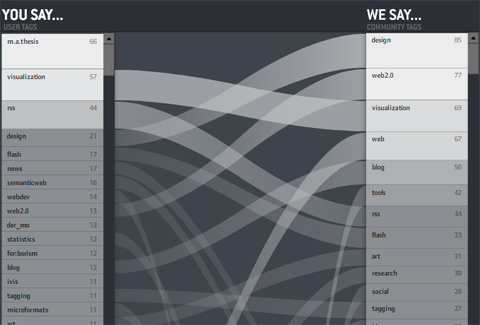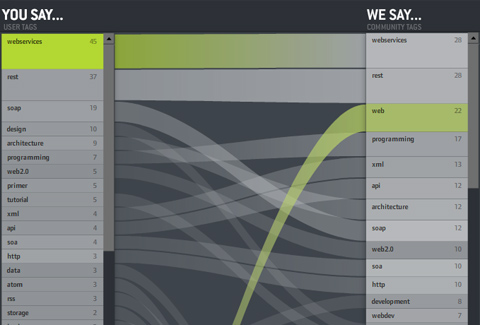You say… We say…
Another visual experiment on tagging:
How do individuals use tags — compared to the community? Do you use private language or are you a mainstream tagger? When you tag with “design” — do the others think it is “art”?

On the left: the personal tags for the personal bookmarks — ordered by frequency — the containing box per is log-scaled so you get an impression of the long–tail position of a tag. Which means: Often used tags are large, bright and go to the top.
On the right: community tags for the tagged ressources.
In the middle: tags with the same name are connected. If a line is horizontal, the indvidual and the community essentially agree on the relevance of the tag for the ressources. The steeper it is — the larger the disagreement. If no line starts at a tag, it means it is not present in the other list
So in the picture above, you can see my tags. Same facts you can read from the picture:
• “m.a.thesis” is a very often used, but private tag of mine.
• The ressources I tag in general are mostly tagged with “design” by the community. I, however, use the tag “design” much less often.
• “news”, “semantic web”, “webdev” are tags I use often, but not the community.
etc.

And often course, you can click individual tags to see what the comparison is like for subsets of the bookmarks. That’s especially interesting for obscure tags like “guru” — you can see what the tagger “means” by looking at the distribution of the community bookmarks (in this case “design – art – programmer – artist”). Interesting!
Some more shots:


I wish I could say “click here for the interactive version” as usual — but unfortunately, del.icio.us offers a JSON API, but did not put a crossdomain.xml file on their server. Which means the visualization (which runs nicely on my harddisc) cannot load data when put in the web. Bummer. I hope I can figure something out.
So for now — I can only offer a download link. Click the index.html. You might have to adjust you Flash player security settings in order to load the community tags. Caveat: The application is still a bit buggy and pretty heavy concerning processor ressources.
Husserl and tagging
A very nice paper on the “laissez-faire librarianship” often associated with tagging vs. more structured semantic web approaches. Most notable is that the discussion is put in the context of Husserl’s theory of reflections, intentionality and intersubjectivity.
D. Grant Campbell
Faculty of Information and Media Studies
University of Western Ontario
London, Ontario N6A 5B7, Canada
Abstract
This paper uses Husserl’s theory of phenomenology to provide a model for the relationship
between user-centered tagging systems, such as del.icio.us, and the more highly structured
systems of the Semantic Web. Using three aspects of phenomenological theory—the movement
of the mind out towards an entity and then back in an act of reflection, multiplicities within unity,
and the sharing of intentionalities within a community—the discussion suggests that both tagging
systems and the Semantic Web foster an intersubjective domain for the sharing and use of
information resources. The Semantic Web, however, resembles traditional library systems, in
that it relies for this intersubjective domain on the conscious implementation of domain-centered
standards which are then encoded for machine processing, while tagging systems work on
implied principles of emergence.